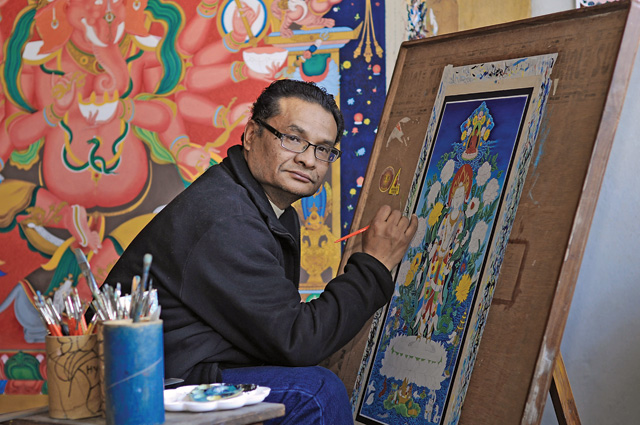Preserving the practice of the traditional arts.

Founded in 1998 by Lok Chitrakar, a traditional artist, Simrik Atelier got its name from the color simrik or crimson which is Nepal’s national color and denotes compassion. He did not term it as a studio or gallery because he wanted to avoid giving a wrong impression of a photo studio or a place to be hired to display paintings. The philosophy behind opening this center was to preserve the dying tradition of Newar Art, as a School for Newar Art. He believes that after photography was introduced to Nepal this rich traditional art, in the form of Pauhba Paintings was slowly dwindling away. It was revived after 1950 when it found many patrons from outside. Coming from a Chitrakar family he shouldered the responsibility of preserving this legacy and building on it by opening this atelier which is his personal studio as well as a space where he mentors those interested in this art.
The first few students worked as apprentices under him, Rajendra Maharjan and two Tamang boys were his first students. Maharjan tutored at the atelier for 18 years and is still practicing Paubha paintings till day. The students here undergo practical training under the tutor; the theoretical part comes together with the practice and is not taught separately. Till today, Lok Chitrakar is the sole tutor at Simrik Atelier however he has plans to institutionalize the training by providing a 14-month course on semester basis, with fixed course curriculum. Underprivileged students will also have fixed quota to promote this arts. Here, emphasis is laid on iconography, iconometry and the religious philosophy. Paubha paintings are based on religious themes, both Hindu and Buddhist made on cloth. The central deity and all associated minor gods, goddesses, symbols and icons are drawn according to various religious texts which dictate the iconometry, asanas, mudras, ayudas, vahana, colour and so forth of the deities. The students are first encouraged to sketch the deities, then paint them with poster colour and after they have mastered the techniques they are introduced to stone or mineral colours. A maximum number of 12 students will be taken for each semester.
Coming to this center are Nepalese, Japanese, Finnish, Polish, Swiss and Americans to explore and learn this form of traditional art. Students from Kathmandu University, Centre for Arts & Design, also come to the atelier to learn as a part of their academic course.
Presently Ryuzo Chijiki from Japan and Chelsea Wiebers from the USA have been studying here since the past last year. Chijika has come to Nepal to learn the tantric art. His project is to make a copy of the Hey Vajra Mandala, earlier made by Lok Chirtakar. Wiebers is a student of Buddhist Art History and is here to learn Paubha paintings and is also helping in making the curriculum of the courses due to begin soon.
The center focuses on providing training so that the artists can earn a living through this art form. This traditional art is a legacy which has been inherited by us through our ancestors and the center aims to give continuity to the Newar art, which is an integral part of the Nepalese culture.










